#valley of the kings
Explore tagged Tumblr posts
Text
Chariot Body of Thutmose IV

Deep in the Valley of the Kings, archaeologist Howard Carter uncovered something remarkable in 1903 — the nearly 3,400 year-old chariot body of Thutmose IV, the 8th pharaoh of the 18th Dynasty of Egypt.
Found in his tomb, KV 43, this chariot is one of the few Egyptian examples to survive into the modern day.
It was part of the king’s burial items, meant to serve him in the afterlife and offers a rare glimpse into the past.
Made from lightweight wood, the chariot was designed for speed and maneuverability, essential for both battle and ceremony.
It wasn’t just practical. It was also beautifully decorated, likely with gold leaf, leather, and intricate designs.
These details highlighted the king’s power and status, fitting for a ruler who was both a warrior and a god-like figure.
The discovery of Thutmose IV's chariot gives us a valuable look at the engineering and artistry of the 18th Dynasty.
Despite being buried for millennia, its preservation helps us understand the significance of chariots in ancient Egypt and showcases the skill of its craftsmen.
📍Egyptian Museum, Cairo
#Thutmose IV#Howard Carter#valley of the kings#KV 43#egyptian pharaoh#pharaoh#chariot#burial items#funeral#afterlife#ancient egypt#ancient civilizations#engineering#artistry#18th dynasty#Egyptian Museum#Cairo#archaeology#craftmanship
153 notes
·
View notes
Text
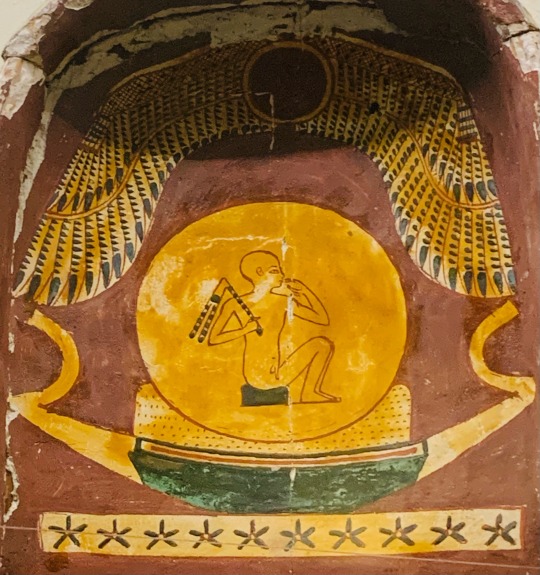
Ra, in his form as the Solar Child.
#Ra#sun god#ancient egypt#egyptian#egyptology#egyptian archaeology#valley of the kings#tomb#Kemet#Kemetic#kemeticism
245 notes
·
View notes
Text

‘Curse’ Behind King Tutankhamun’s Tomb Mysterious Deaths Finally Solved
The unsettling curse of King Tutankhamun’s tomb in Egypt has bewildered archaeologists since it’s been feared to be linked to the mysterious deaths of multiple excavators who discovered it in 1922.
However, a scientist now claims to have solved the mysteries of the infamous “Pharaoh’s Curse” more than 100 years later.
Toxic levels of radiation emanating from uranium and poisonous waste are believed to have lingered inside the tomb since it was sealed over 3,000 years ago, Ross Fellowes wrote last month in the Journal of Scientific Exploration (JSE).
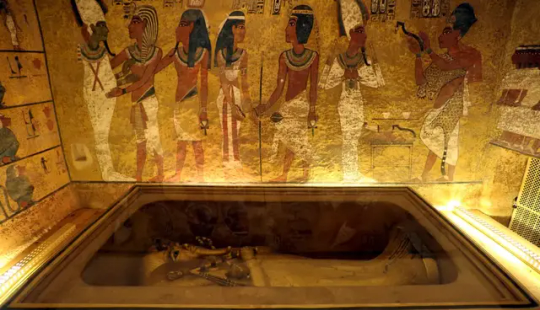
The burial chamber in the tomb of Tutankhamun, near Luxor, Egypt.
The radiation level inside Tutankhamun’s tomb is so high that anyone who comes in contact with it could very likely develop a fatal dose of radiation sickness and cancer.
“Both contemporary and ancient Egypt populations are characterized by unusually high incidences of hematopoietic cancers, of bone/blood/lymph, for which a primary known cause is radiation exposure,” Fellowes wrote in his study.
However, this radioactivity isn’t isolated to Tutankhamun’s tomb.
Fellowes revealed that “unusually high radiation levels have been documented in Old Kingdom tomb ruins” and spread throughout sites in Egypt.
“Radiation has been detected by the Geiger counter at two sites at Giza adjacent to the pyramids,” he wrote, adding that radon — a radioactive gas — has also been detected in “several underground tombs at Saqqara.”
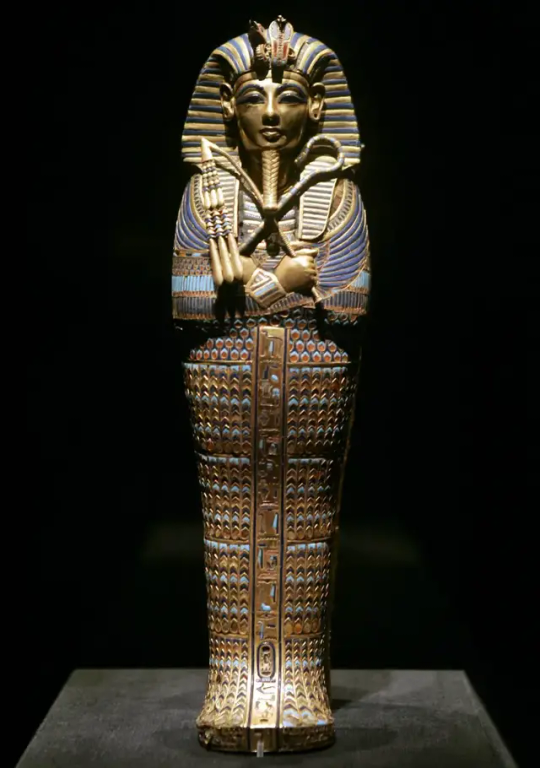
The “Coffinette for the Viscera of Tutankhamun,” which contained the king’s mummified liver, depicts him as Osiris, holding a crook and flail.
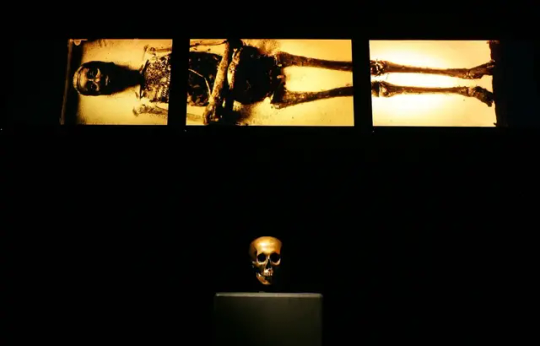
Medical imagery of Tutankhamun is shown above a replica of King Tut’s skull on display during the “Tutankhamun And The Golden Age Of The Pharaohs” at the Los Angeles County Museum of Art in California.
These readings were all found to be “intensely radioactive.”
“Modern studies confirm very high levels of radiation in ancient Egyptian tombs, in the order of 10x accepted safety standards,” the study shared.
It’s also theorized that those who built the ancient tombs were aware of the toxins based on the eerie warnings carved on the walls.
“The nature of the curse was explicitly inscribed on some tombs, with one translated presciently as, ‘they that break this tomb shall meet death by a disease that no doctor can diagnose,’” Fellowes wrote.
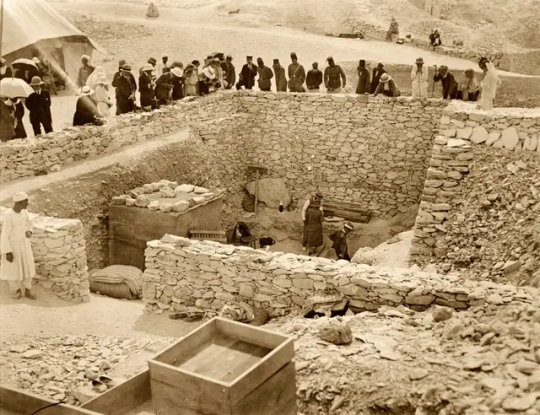
Outside the tomb of Tutankhamun during the 1922 excavation in the Valley of the Kings in Egypt.
Other ominous translations like “forbidden” because of “evil spirits” may have significantly fueled the fear that supernatural curses lingered in the ancient sites.
Those fears intensified with the mysterious deaths of Lord Carnarvon, who funded the excavation in 1922 and reportedly walked through the treasured filled rooms — and multiple others after they unsealed the tomb.
“Carnarvon was dead within a few weeks of the uncertain diagnosis of blood poisoning and pneumonia,” Fellowes wrote.
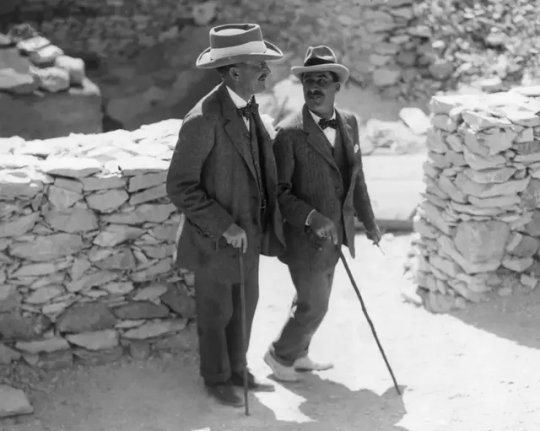
Egyptologist Howard Carter (R) walks with archaeologist Lord Carnarvon, the patron of his research, outside the tomb of King Tutankhamun in 1922.
Egyptologist Arthur Weigall allegedly told colleagues that Carnarvon would “be dead within six weeks” upon entering, the study claimed.
Howard Carter, the first person to walk inside Tutankhamun’s tomb with Carnarvon, died in 1939 after a long battle with Hodgkin’s lymphoma, which was suspected to be caused by radiation poisoning.
British Egyptologist and independent excavator Arthur Weigall was present at the opening of Tut’s Tomb and is also credited with starting the ‘myth’ of the curse.
He died of cancer at 54 years old in 1934.
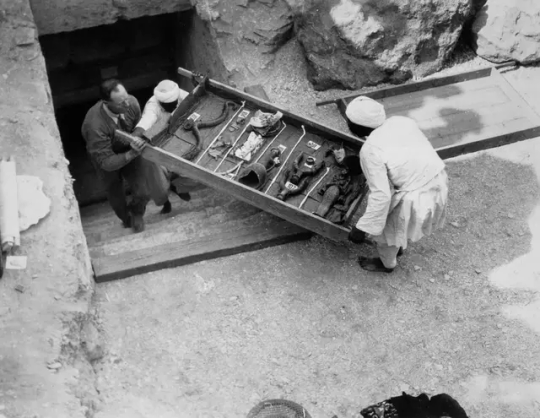
Workers remove a tray of chariot parts from the Tomb of Tutankhamun in the Valley of the Kings, Egypt, in 1922.
In total, six of the 26 people present when the tomb was opened died within a decade from asphyxia, stroke, diabetes, heart failure, pneumonia, poisoning, malaria and X-ray exposure.
While the deaths can be seen as odd, the curse theory was also likely fueled by the oddities that happened when it opened.
Carnarvon had reportedly suffered a mosquito bite that became severely infected.
Around the time excavators opened the tomb, Cairo reportedly suffered a bizarre power outage and a freak sandstorm, according to National Geographic.’
At one point during the excavation, Carnarvon’s favorite dog allegedly let out a chilling howl and suddenly dropped dead.
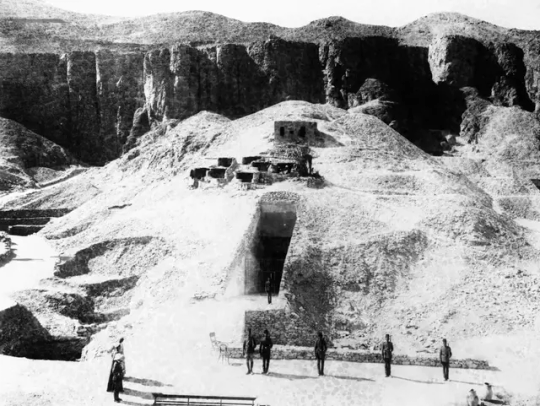
A photograph showing guards standing outside the tomb of Tutankhamun in Egypt in 1922.
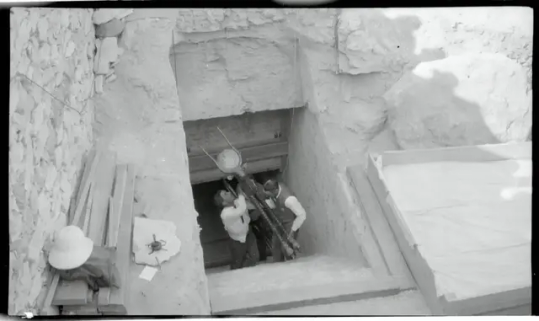
A sacred cow being removed from Tomb of Tutankhamun in 1922.
From a historical perspective, the discovery of the tomb in the Valley of Kings is considered one of the most fascinating finds that gave modern society a glimpse into the Egyptian royalty voyage into the afterlife.
Five thousand items, including solid gold funeral shoes, statues, games, and strange animals, were discovered inside Tutankhamun’s tombs.
It would take the excavators ten years to clear the tomb of its treasure.
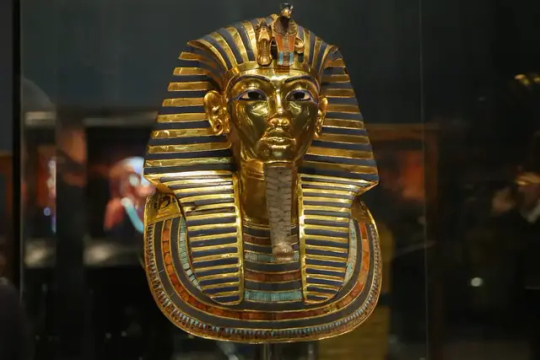
The golden funerary mask of Tutankhamun.
The unsealing and studying of the tomb is also credited with launching the modern era of Egyptology.
Tutankhamun took the throne as pharaoh around nine or ten years old and ruled between 1332 BC and 1323 BC.
However, he died by the time he turned 18.
There are no surviving records of Tutankhamun’s death and how the young pharaoh died remains a mystery.
However, Tutankhamun is suspected to have suffered from several health issues — likely linked to his father, Akhenaten, and his mother, Nefertiti, being brother and sister.
By Richard Pollina.
#‘Curse’ Behind King Tutankhamun’s Tomb Mysterious Deaths Finally Solved#King Tutankhamun#Pharaoh’s Curse#Old Kingdom#Valley of the Kings#Lord Carnarvon#Howard Carter#Egyptology#ancient artifacts#archeology#archeolgst#history#history news#ancient history#ancient culture#ancient civilizations#ancient egypt#egyptian history#egyptian mythology#egyptian pharaoh#egyptian antiquities#egyptian art
78 notes
·
View notes
Text

Ceremonial Throne of Tutankhamun aka Tutankhamun’s Ecclesiastical Throne
New Kingdom, late 18th Dynasty, reign of Tutankhamun, ca. 1332-1323 BC. From the Tomb of Tutankhamun (KV62), Valley of the Kings, West Thebes. Now in the Egyptian Museum, Cairo.
#egypt-museum.com#reddit#artefactporn#new kingdom#sartew#tutankhamun#king tut#tutankhamun’s ecclesiastical throne#late 18th dynasty#cairo#egyptology#kv62#egyptian#tomb of tutankhamun#1332-1323 bc#egypt#valley of the kings#west thebes#egyptian museum#ceremonial throne of tutankhamun
13 notes
·
View notes
Text
Valley of the Kings, Egypt...






#travel#egypt#ancient egypt#egyptian#egyptology#valley of the kings#africa#north africa#africa travel#hieroglyph#pharoah#ancient history#egyptian gods#egyptian mythology#egyptian mummy
13 notes
·
View notes
Text
#ancient Thrace#Valley of the Kings#I really liked visiting Bulgaria#I'd go back and see the Black Sea Coast next time#Kazanlak Tombs#Thracian tombs are very cool
13 notes
·
View notes
Text
The chariot of Thutmose IV
El carro de Tutmosis IV

(English / Español / Italiano)
Deep in the Valley of the Kings, archaeologist Howard Carter discovered something extraordinary in 1903: the almost 3,400-year-old body of Thutmose IV in his tomb, KV 43. This chariot is one of the few Egyptian examples to have survived to the present day. It was part of the king's funerary objects, intended to serve him in the afterlife, and offers a rare glimpse into the past.
The chariot, made of light wood, was designed to be fast and manoeuvrable, essential for both battle and ceremonial purposes. Not only was it practical, but it was also beautifully decorated, probably with gold leaf, leather and intricate designs. These details emphasised the king's power and status, appropriate for a ruler who was both a warrior and a divine figure.
The discovery of the chariot of Thutmose IV provides valuable insight into the engineering and art of the 18th Dynasty. Despite being buried for millennia, its preservation helps us to understand the importance of chariots in ancient Egypt and shows the skill of its craftsmen.
----------------------------------------------------------------------------
En las profundidades del Valle de los Reyes, el arqueólogo Howard Carter descubrió algo extraordinario en 1903: el cuerpo de Tutmosis IV, de casi 3.400 años de antigüedad, que se encuentra en su tumba, KV 43. Este carro es uno de los pocos ejemplos egipcios que han sobrevivido hasta nuestros días. Formaba parte de los objetos funerarios del rey, destinados a servirle en el más allá, y ofrece una visión poco común del pasado.
El carro, hecho de madera ligera, fue diseñado para ser rápido y maniobrable, algo esencial tanto para la batalla como para las ceremonias. No solo era práctico, sino que también estaba bellamente decorado, probablemente con pan de oro, cuero y diseños intrincados. Estos detalles resaltaban el poder y el estatus del rey, algo apropiado para un gobernante que era a la vez un guerrero y una figura divina.
El descubrimiento del carro de Tutmosis IV nos brinda una valiosa perspectiva de la ingeniería y el arte de la XVIII Dinastía. A pesar de estar enterrado durante milenios, su conservación nos ayuda a comprender la importancia de los carros en el antiguo Egipto y muestra la habilidad de sus artesanos.
----------------------------------------------------------------------------
Nel profondo della Valle dei Re, nel 1903 l'archeologo Howard Carter scoprì qualcosa di straordinario: il corpo di Thutmose IV, risalente a quasi 3.400 anni fa, nella sua tomba KV 43. Questo carro è uno dei pochi esemplari egizi sopravvissuti fino ai giorni nostri. Faceva parte del corredo funerario del re, destinato a servirlo nell'aldilà, e offre un raro sguardo sul passato.
Il carro, realizzato in legno leggero, era progettato per essere veloce e maneggevole, essenziale sia per la battaglia che per le cerimonie. Non solo era pratico, ma era anche splendidamente decorato, probabilmente con foglie d'oro, pelle e disegni intricati. Questi dettagli sottolineavano il potere e lo status del re, appropriati per un sovrano che era sia un guerriero che una figura divina.
La scoperta del carro di Thutmose IV offre una preziosa visione dell'ingegneria e dell'arte della XVIII dinastia. Nonostante sia stato sepolto per millenni, la sua conservazione ci aiuta a capire l'importanza dei carri nell'antico Egitto e mostra l'abilità dei suoi artigiani.
Source: Diario de Historia
#ancient egypt#antiguo egipto#XVIII dinastia#18th dynasty#Thutmose IV#valle dei re#valle de los reyes#valley of the kings
12 notes
·
View notes
Photo
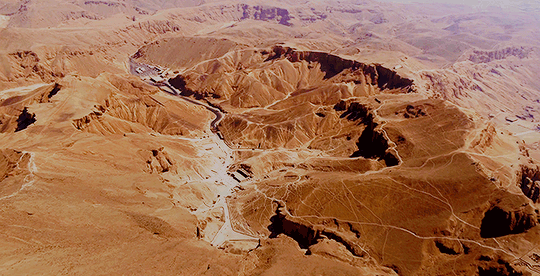

The Valley of the Kings is located in a valley behind the Theban Hills. To the far right can be seen the causeway up to the mortuary temple of Hatshepsut at Deir el-Bahari.��The Theban Hills are dominated by the peak of al-Qurn, known to the Ancient Egyptians as ta dehent, or "The Peak". It has a pyramid-shaped appearance, and it is probable that this echoed the pyramids of the Old Kingdom, more than a thousand years prior to the first royal burials carved here. Its isolated position also resulted in reduced access, and special tomb police (the Medjay) were able to guard the necropolis. [X]
176 notes
·
View notes
Text

#acorigins#assassin's creed#assassin's creed origins#workers' necropolis#valley of the kings#ubisoft#photomode#gamingedit#virtual photography#gaming photography#pc gaming#pc share#camera tools
17 notes
·
View notes
Text
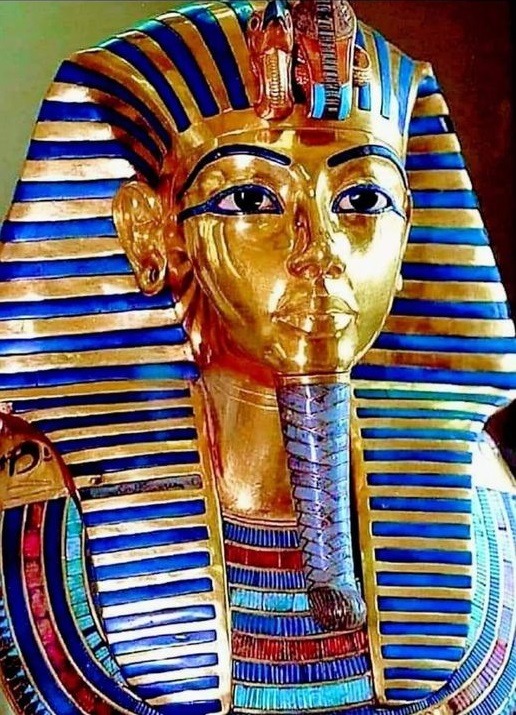
the mask of Tutankhamun
#mask of Tutankhamun#Tutankhamun#tutankamon#tutankhamun#tutankhamun's mask#funerary mask#funerary mask of Tutankhamun#howard carter#1925#valley of the kings#cairo#egyptian museum
13 notes
·
View notes
Text


Valley of the Kings, Luxor, Egypt.
#travel destinations#travel aesthetic#egyptology#egypt#luxoregypt#luxor#valley of the kings#ancient egypt#travel
9 notes
·
View notes
Text
Canopic Chest of Tutankhamun (1342-1324 BC)

New Kingdom, late 18th Dynasty, from the Tomb of Tutankhamun (KV62), Valley of the Kings, West Thebes, Luxor, Egypt.
—
Canopic chests are cases used by ancient Egyptians to contain the internal organs removed during the process of mummification.
Once canopic jars began to be used in the late 4th Dynasty, the jars were placed within canopic chests.
Although the first proven canopic burials date from 4th Dynasty reign of Sneferu, there is evidence to suggest that there were canopic installations at Saqqara dating from 2nd Dynasty.
The first canopic chests were simple and wooden, but as time went on, they became more elaborate.
Then, around the 21st Dynasty (1069–945 BC), Egyptians decided to leave the viscera inside mummies.
But because they had been using canopic chests for thousands of years, they kept putting them in tombs, just without anything in them.
Canopic chests fell out of use during Ptolemaic Kingdom.
The style and materials were different at different times, though always reflected Egyptian ideal of perfectly measured and precise beauty.
This alabaster canopic chest of Tutankhamun is considered to be one of the finest masterpieces of King Tut’s collection.
The interior of the chest is divided into four compartments, each with a cylindrical hollow covered by a lid elegantly carved in the form of the king’s head.
At the four corners of the chest, carved in high relief, are four goddesses: Isis, Nephthys, Neith and Serket — who stretch out their arms to protect the contents of the chest.
Each of the four compartments of the canopic chest held a miniature coffin. Covered in linen, they stood upright in their cylindrical compartments.
Each was almost glued to the bottom owing to the hardening of the unguents that had been poured in as part of the ritual.
It was the duty of the goddess Nepthys, whose name is inscribed on the front, to protect the lungs of Tutankhamun, which were placed inside, after first being preserved.
The figure, fashioned of solid beaten gold, contains inlays of colored glass and semiprecious stones.
It is very close in design to the second coffin in which Tutankhamun was buried; in fact, it is almost a miniature version.
📍 Egyptian Museum, Cairo (JE 60687)
#canopic chests#mummification#internal organs#ancient egypt#canopic jars#Sneferu#Tutankhamun#King Tut#Isis#Nephthys#Neith#Serket#miniature coffin#Nepthys#Egyptian Museum#Cairo#Egypt#burial#ritual#afterlife#Tomb of Tutankhamun (KV62)#Valley of the Kings#West Thebes#Luxor
27 notes
·
View notes
Text

Dua Ra-Horakhty
#Ra-Horakhty#Ra#Horus#Kemet#Kemeticism#Kemetic#Egypt#egyptology#Egyptian#ancient egypt#ancient Egyptian#valley of the kings#egyptian gods#Luxor#Thebes
74 notes
·
View notes
Text

King Tut’s Iconic Death Mask Was Intended for Someone Else
Research from the University of York points to an "overlooked clue" hiding in plain sight.
Tutankhamun’s death mask is one of the most-recognized images around the globe. Measuring 21 inches tall, inlaid with a detailed mosaic of precious stones, and featuring a 5.5 lb golden beard, the artifact is surely one of the world’s most iconic objects. But researchers think that the pharaoh’s ears may be hiding a secret in plain sight.
The death mask was found in 1925 by the Egyptologist Howard Carter during his excavations of Tutankhamun’s tomb which his team rediscovered in 1922 in the Valley of the Kings near the city of Luxor. Carter’s records are kept at the University of Oxford’s Griffith Institute which was established 17 years after Carter first discovered Tutankhamun’s tomb as the center for Egyptology at the university, named after the university’s first Professor of Egyptology, Francis Llewellyn Griffith.
Tutankhamun, known as the “Boy King,” came to the throne aged just nine and ruled Egypt for around nine years between ca. 1332 and 1323 BCE. He was riddled with ailments including scoliosis and a cleft palate, thought to be due to his parents being brother and sister.


But new research out of the University of York suggests that the mask was not originally designed for the young Pharaoh, and was instead intended for a regal female burial—perhaps Tutankhamun’s stepmother Queen Nefertiti who died before Tutankhamun, though no specific date for her death is known. This theory hinges on one key detail of the death mask: Tutankhamun’s pierced ears.
Piercings were typically only found on the death masks of female rulers and children. Lead researcher Professor Joann Fletcher said in a documentary for History Hit in 2022 that “research suggests that the King wouldn’t have worn earrings beyond childhood, so by the age of 20 when he died he would not have been portrayed with pierced ears” calling the pierced ears of the mask a “long-overlooked feature”.
When compared, the gold used on the face of Tutankhamun is entirely different to the gold used on the rest of the mask, suggesting—as Fletcher put it—that Tutankhamun’s face was “effectively grafted on” to the pre-existing mask of a previous—and likely female—ruler.



There is no doubt, however, that the likeness is of King Tut, as the likeness of a death mask was considered imperative should the person’s soul be able to be reunited with their body for judgement by the god of funerary practices and guide to the underworld, Anubis, after their death.
“I was sure the death mask was not specifically designed for King Tut”, Fletcher said.
Fletcher suggests that the originally intended recipient of the mask could be the Pharaoh Nefertiti, who married and ruled alongside Tutankhamun’s father Pharaoh Akhenaten. This theory was first proposed in 2015 by the British Egyptologist Nicholas Reeves. There is scholarly debate about whether Nefertiti ruled as pharaoh on her own for a short time between her husband’s death and Tutankhamun ascending to the throne. Nefertiti’s tomb has never been discovere
The reason for this make-do-and-mend approach to the burial of, at that point, the most powerful and wealthy man in Egypt may be due to the suddenness of his death, aged around 19. Theories on Tutankhamun’s cause of death have included murder, but it is currently believed that he passed away from malaria and an infection the young ruler developed after a serious chariot crash which left him with a broken leg at the time of his burial. The lack of preparation for this death may have led to the decision to alter a pre-existing mask rather than commission a new one from scratch. Other details suggesting that Tutankhamun’s burial was hurried were patches of paint on the walls of his tomb which would have still been wet when the tomb was sealed.
The mask is kept in the Grand Egyptian Museum in Cairo, which re-opened last month after an 11 year delay.
By Verity Babbs.

#King Tut’s Iconic Death Mask Was Intended for Someone Else#King Tut#King Tutankhamun#Boy King#Howard Carter#Valley of the Kings#ancient tomb#ancient grave#gold#gold mask#ancient artifacts#archeology#archeolgst#history#history news#ancient history#ancient culture#ancient civilizations#ancient egypt#egyptian history#egyptian art#ancient art
41 notes
·
View notes
Text
Random Fact #6,516
The oldest worker strike we know of was at the building site of the pyramid for Ramses III.
What were they striking about? Poor wages.
The workers didn't just refuse to construct Rameses III’s future tomb either, they actually occupied the Valley of the Kings and were preventing anyone from entering to perform rituals or funerals.
Another strike from around the same time was about the lack of provision of sunscreen (so, basically, occupational safety).
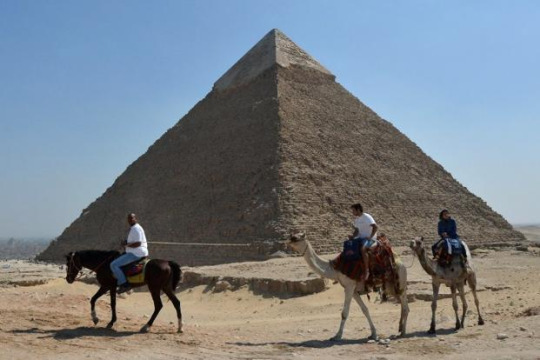
#picket line#strike#did you know#random facts#little known fact#random fact#random factoid#random factoids#history facts#worker's rights#egypt#egyptian history#ramses iii#health and safety#valley of the kings#yes really
48 notes
·
View notes
Text
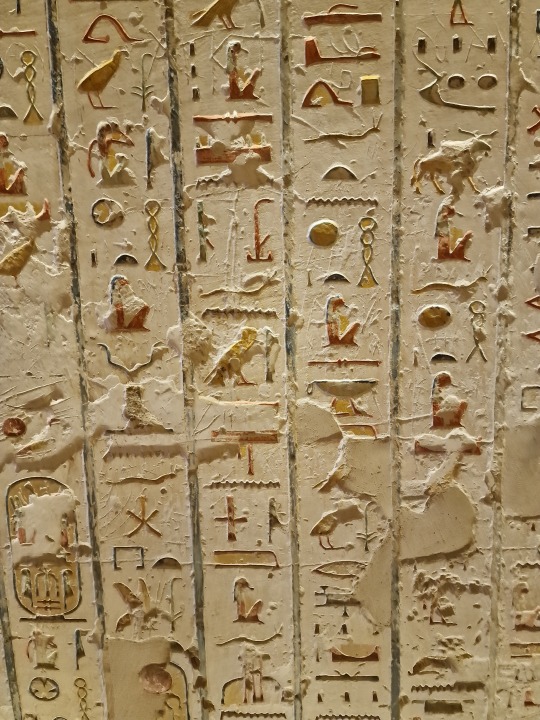
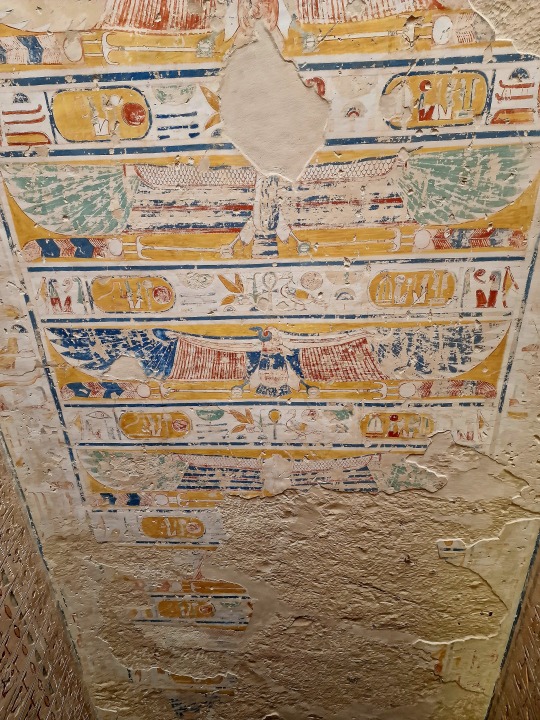


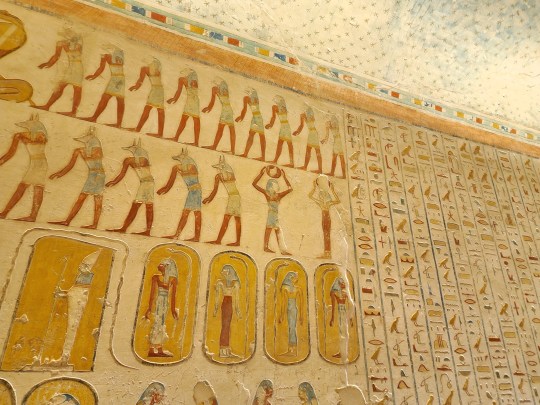
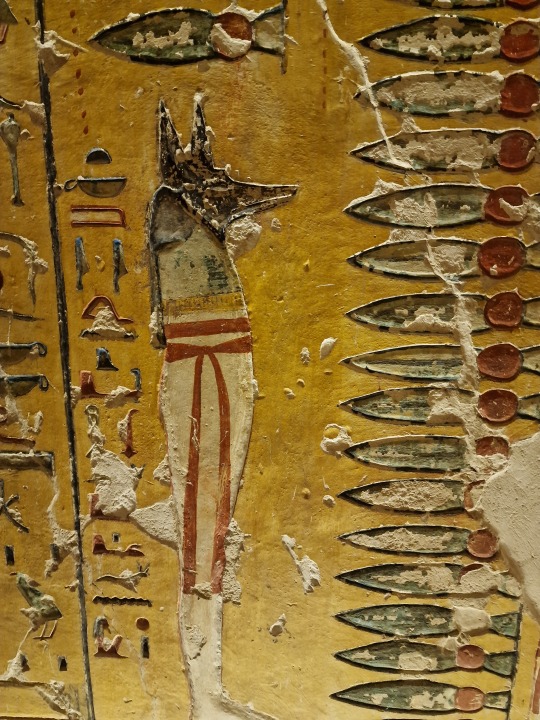




Túmulo de Ramsés IV
Vale dos Reis
Egipto
fotos cjmn
36 notes
·
View notes